Boxing
Boxing
A Concise History of the Sweet Science
Gerald R. Gems
ROWMAN & LITTLEFIELD
Lanham Boulder New York Toronto Plymouth, UK
Published by Rowman & Littlefield
4501 Forbes Boulevard, Suite 200, Lanham, Maryland 20706
www.rowman.com
10 Thornbury Road, Plymouth PL6 7PP, United Kingdom
Copyright 2014 by Rowman & Littlefield
All rights reserved. No part of this book may be reproduced in any form or by any electronic or mechanical means, including information storage and retrieval systems, without written permission from the publisher, except by a reviewer who may quote passages in a review.
British Library Cataloguing in Publication Information Available
Library of Congress Cataloging-in-Publication Data
Gems, Gerald R.
Boxing : a concise history of the sweet science / Gerald R. Gems.
pages cm
Includes bibliographical references and index.
ISBN 978-1-4422-2990-7 (cloth : alk. paper) ISBN 978-1-4422-2991-4 (ebook)
1. BoxingHistory. 2. BoxingSocial aspectsHistory. I. Title.
GV1121.G47 2014
796.8309dc23 2013040171
 The paper used in this publication meets the minimum requirements of American National Standard for Information SciencesPermanence of Paper for Printed Library Materials, ANSI/NISO Z39.48-1992.
The paper used in this publication meets the minimum requirements of American National Standard for Information SciencesPermanence of Paper for Printed Library Materials, ANSI/NISO Z39.48-1992.
Printed in the United States of America.
To my father (19182005), regimental boxing champion and still my hero.
Contents
Acknowledgments
Thanks to Christen Karniski, acquisitions editor at Rowman & Littlefield, for offering me the opportunity; to Professor Gertrud Pfister for her research assistance and the procurement of European sources and photos; to Professors Jan and Terry Todd for their contribution of photos from their vast collection; to Frank Di Benedetto for the LaMotta-Robinson photo; and to research assistants Aubrie Luesse, Derek Nelson, and Zach Heerspink.
Introduction
Pierce Egan first called boxing the sweet science of bruising in Boxiana , his account of the early nineteenth-century prizefighting scene in England, but there has long been a fascination with the brutal confrontation of individuals in a demonstration of physical and psychological superiority. Greek and Roman sculptors depicted the athletic ideals of the ancient era in the form of boxers. Hieronymous Mercurialis used Roman boxers as illustrations in his Renaissance work De Arte Gymnastica , in 1573. Egans Boxiana (1812) is copiously illustrated with the boxing heroes of that time, while Thomas Eakins, George Bellows, and LeRoy Neiman have captured the continued appeal of boxers and boxing in the modern era. Their works address the norms, values, and social transformations of society over the past century.
Despite the inherent brutality and countless human tragedies occurring in the ring, some see a work of art in the choreographed performance of ducking, feinting, footwork, and the rhythmic staccato of punches. Sugar Ray Robinson brought a particular elegance to the sport both inside and outside the ring. Muhammad Ali exhibited a flair and exuberance that extended well beyond the battleground. Sugar Ray Leonard borrowed from both in what has been termed a poetry of physical action.
Maurice Maeterlinck, a Belgian poet, playwright, and winner of the Nobel Prize in 1911 (18621949), explained that in the boxers stance, one of the most beautiful positions taken by the male physique, all the muscles of the body become legible. From head to toe not a single ounce of strength is wasted. Every ounce is directed toward one or the other of two massive fists, each supercharged with energy.
Writers, both male and female, have been particularly attracted to the human drama that unfolds in the boxing ring. For them, a great fight is a masterpiece of suspense, in doubt until the closing moments. Each round presents a scene in a drama that might increase or relieve tension, a Darwinian struggle, a physical and a psychological contest, a public display of human limitations that involves strategies and counter-strategies of pure combat without weapons other than ones body. It is a type of nonliterary expression, a craft, and in its best forms an art. Boxers converse with their physiques how the seemingly inarticulate become poets with their bodies. David Scott, professor of literature, even claims that boxing has given literature as many great novels as baseball, cinema more classic films than football, and criticism more meaningful essays than tennis.
Robert Musil, an Austrian writer also nominated for the Nobel Prize (18801941), explored the celebratory aspects of great fighters. If one were to analyze a powerful mind and a champion boxer from the psycho-technical point of view, it would in fact turn out that their cunning, their courage, their precision and their combinatory ability, as well as the quickness of their reactions on the territory that they have made their own, are approximately equal.... But apart from this there is one other advantage that... a boxer [has] over a great mind, and that is that their achievement and importance can be indisputably assessed and that the best among them is really acknowledged as the best.
Some writers have sought a more graphic rather than vicarious experience by entering the combat zone. Lord Byron took lessons from prize-fighter John Jackson. He noted on March 20, 1814, that he had [s]parred with Jackson again yesterday morning, and shall tomorrow. I feel the better for it, in spirits, though my arms and shoulders are very stiff from it. Later that same year on June 19, 1814, he stated: My mornings are late, and passed in fencing and boxing, and a variety of most unpoetical exercises, very wholesome, &c., but would be very disagreeable to my friends, whom I am obliged to exclude during their operation. Paul Gallico, one of the premier sportswriters of the interwar era, tested himself against heavyweight champion Jack Dempsey in the ring, which resulted in another knockout for the champ. Heavyweight writers such as Ernest Hemingway and Norman Mailer sparred with boxers, but George Plimptons participatory brand of journalism led him to fight a three-round exhibition with light heavyweight champion Archie Moore at the famed Stillmans Gym in New York in 1959. Plimpton prepped for the encounter by reading The Art and Practice of English Boxing , published in 1807, and by hiring a professional trainer. The bloodshed began in the first round. It was not Moores blood. The boxer graciously carried the writer through the remaining two rounds without any serious threat to his life.
Trevor Wignall, a British sportswriter, co-opted Egans characterization in his own publication, The Sweet Science , in 1926, but the term was best popularized by A. J. Liebling, whose The Sweet Science went through multiple printings and is considered among the best sportswriting ever produced for the general public. This social history of the sweet science is intended as a scholarly synthesis of the sport, not so esoteric as to be incomprehensible to the general public but offering some critical and analytical explanation for the evolution of the sport. Scholars have taken an interest in the sport later than have artists and writers, but they are no less keen on deciphering its racial, ethnic, social, and gendered nuances and meanings. Sociological analyses began in 1952 (Weinberg and Arond) to determine who boxed, when and why they boxed, and what the results were (factual, cultural, medical, and moral). Historians, anthropologists, psychologists, physicians, ethicists, and sociologists have produced a plethora of studies in search of answers since that time.
Over the past half century, boxing has waxed and waned as the sport provided a public stage for the transition in race relations, both in the United States and throughout the world, in the decades following World War II. Italian American boxers symbolized the great white hope versus the encroaching social tide of blacks and Hispanics, a battle played out in the ring and on the streets of urban America. Muhammad Ali represented not only a clarion call for individual, religious, and civil rights in the United States but a global test case for newly independent countries in Africa and Asia that had been former colonies of the white, Western powers. The rise of great black, Hispanic, and Asian champions thereafter sustained an interest in boxing throughout the latter decades of the momentous twentieth century, but the fracturing of boxings administration due to regional and disparate governing bodies, the continued presence of corruption, and the lack of a charismatic heavyweight division have diminished its current relevance. Youth are more drawn to the mixed martial arts and ultimate fighting championships that proliferate in the varied forms of new media.
Next page
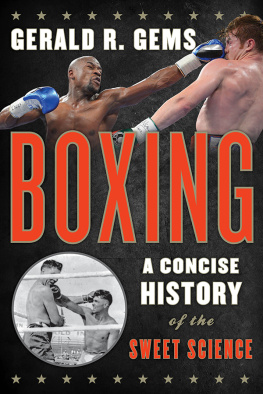
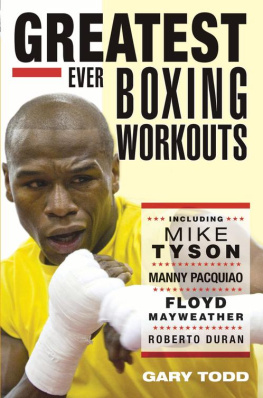
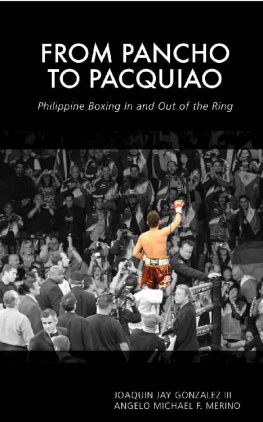

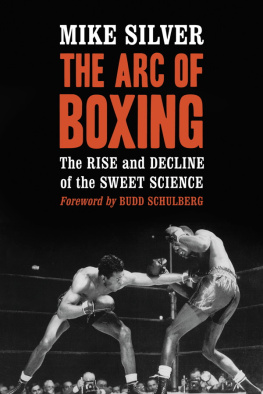
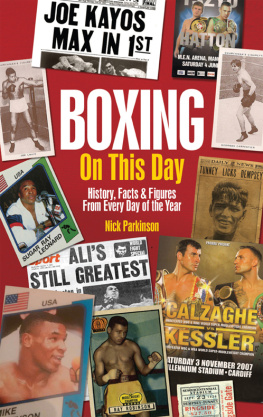
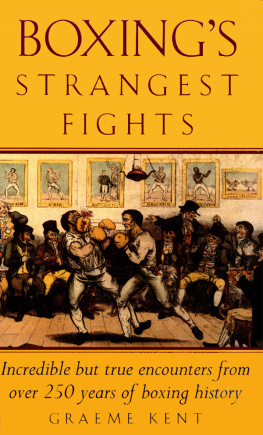

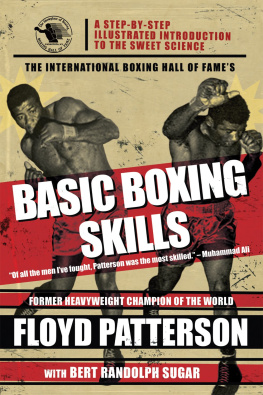
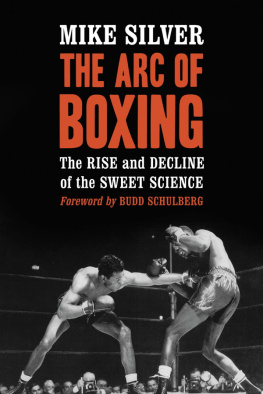
 The paper used in this publication meets the minimum requirements of American National Standard for Information SciencesPermanence of Paper for Printed Library Materials, ANSI/NISO Z39.48-1992.
The paper used in this publication meets the minimum requirements of American National Standard for Information SciencesPermanence of Paper for Printed Library Materials, ANSI/NISO Z39.48-1992.